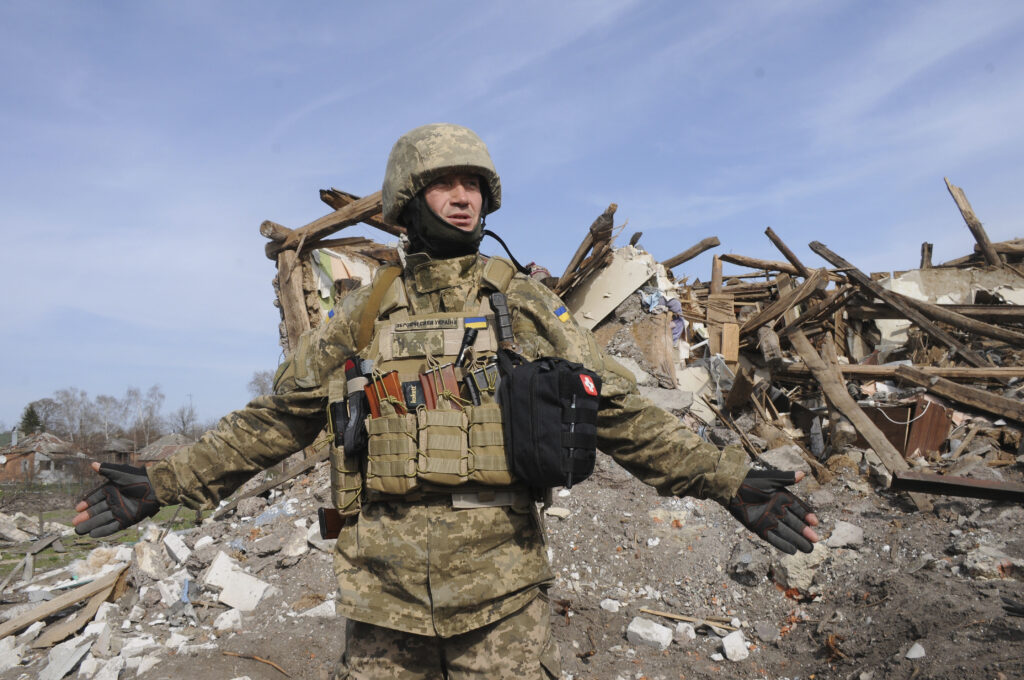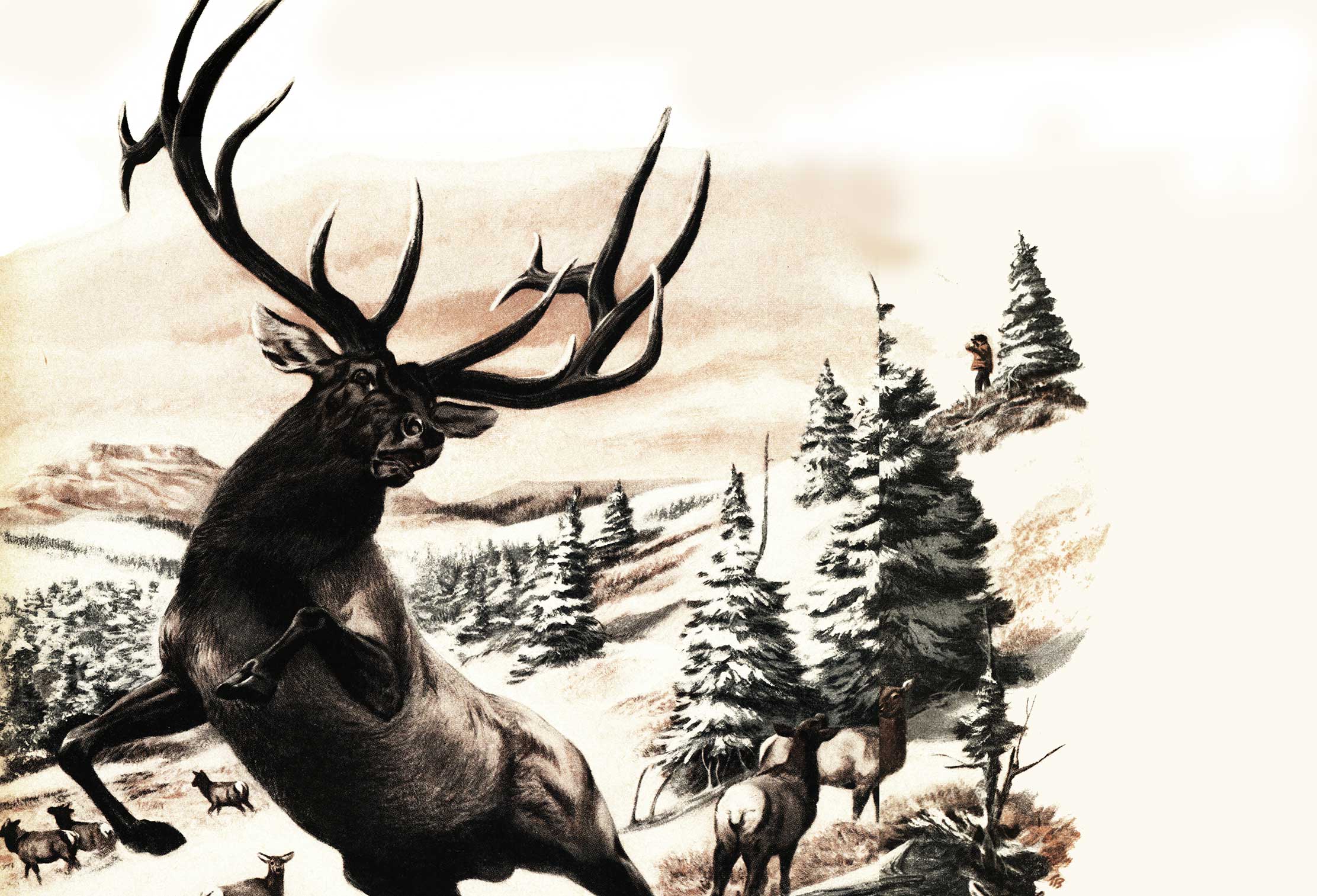Best Camping Tents of 2025, Tested and Reviewed
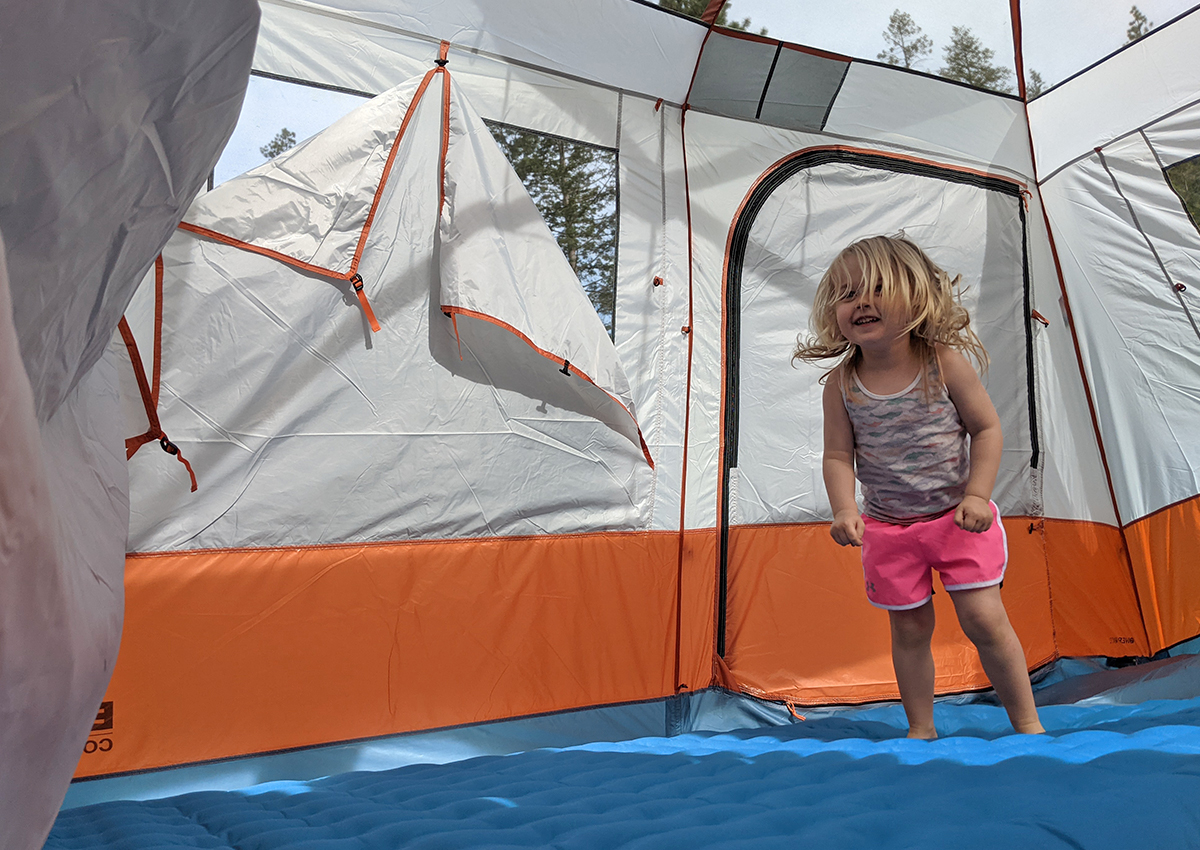
We may earn revenue from the products available on this page and participate in affiliate programs. Learn More ›
A great camping tent can see your family through years — even decades — of outdoor adventures. For Outdoor Life, I’ve tested dozens of models, from four-figure canvas tents to bargain-basement Amazon models, finding great values across a range of brands and for every budget. To help you choose the best camping tent I’ve rounded up a number of my favorite picks here, plus a few new interesting models that should be on every camper’s radar.
The Best Camping Tents: My Top Picks
Best Overall: The North Face Wawona
Photo by Laura Lancaster
Buy the 4-Person
Buy the 6-Person
Buy the 8-Person
Pros
- Good build quality
- Spacious with good head height
- Awesome vestibule
- Limited lifetime warranty
- Relatively small packed size
Cons
- Rainfly setup is a little tricky
- Needs more standard pockets
- Pricey
Key Features
-
Price:
$450 to $750 -
Poles:
4 for the 6-person -
Doors:
2 (3 for the 8-person) -
Pockets:
7
Test Results
-
Ease of Setup:
Good -
Interior Space:
Great -
Head Height:
Great -
Ventilation:
Great
If there is one tent that I’d choose to bring along for a long weekend of camping, it’s The North Face Wawona. I tested the 6-person version of this tent and found it to be incredibly spacious for my family of three, with excellent head height throughout the tent. But what really stands out about this version of the tent is its vestibule. This thing is massive. It has plenty of space to help a kid do a quick clothing change in the middle of the day without needing to take off shoes to head inside the tent. It was so big we ended up leaving one of the best camping chairs set up in the vestibule, handy for stashing coats or sitting down to tie up shoes for a quick day hike.
The setup for this one is a little different than for other tents I’ve tested. It starts, as they all do, with two crisscrossing poles that run through sleeves and then attach into grommets at the four corners. The next pole arches through a sleeve above the front door, hooking into a second set of grommets positioned about a third of the way back along the tent’s length. This has the effect of pulling the tent up not only along the entrance of the tent, making getting in and out of it a breeze, but also the ceiling running up to the center of the Wawona.
If there was one spot I struggled with this tent, it was in setting up the rainfly. The cut is unusual, as camping tents go, and it took me a bit of time to orient myself to it. But once I had it on straight, it was easy enough to clip in and secure the final pole.
The biggest issue with this tent, for most people, will be the price. It’s nearly twice the price of some other picks on this list for the same amount of floor space. For me, the massive vestibule and the inclusion of proper DAC poles (as opposed to the fiberglass of so many disposable tents) along with a limited lifetime warranty make the upgrade more than worth it.
I could have used a few more pockets in the Wawona. Oddly, a few of the tents pockets are on the back door of the tent — not ideal if you want to use that door to get into and out of the tent. Finally the 6-person version of this tent, fully set up with its spacious vestibule, does not quite fit on a tent pad — potentially an issue at stricter campgrounds.
Best Budget: Kelty Rumpus
Photo by Ashley Thess 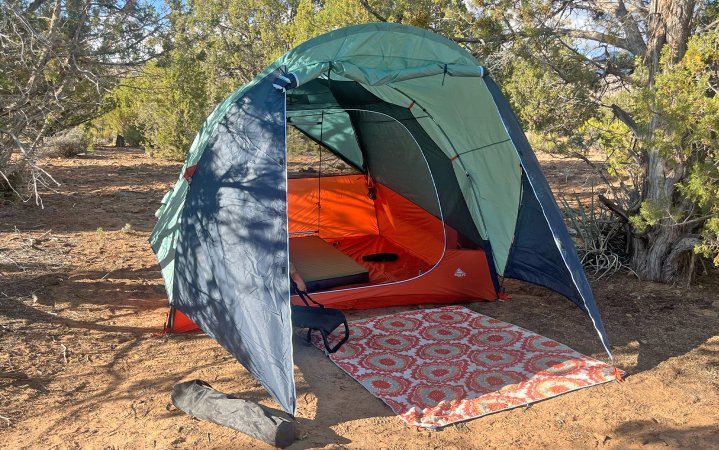
Buy the 4-Person
Buy the 6-Person
Pros
- Good price
- Cozy vestibule
- Good ventilation
Cons
- On the small size
- Unreliable in extreme weather
Key Features
-
Price:
$230 to $300 -
Poles:
3 -
Doors
2 -
Pockets:
4
Test Results
-
Ease of Setup:
Good -
Interior Space:
Good -
Head Height:
Great -
Ventilation:
Good
I took the Rumpus 6 on a spring desert camping trip that called for rain and blistering heat. Once I got the two (very long) criss-crossing poles into their sleeves, it already looked like a mesh palace. Then, I flung the rainfly overtop to erect the spacious front vestibule with the last pole. With the vestibule and back door open, the tent received plenty of ventilation for my partner to take a nap while it was still hot out. And I had plenty of room to stretch and read on the “front porch.”
The following evening we received a light downpour and even the mild winds shook the Rumpus vigorously. I wouldn’t trust the fiberglass poles on this budget tent in very extreme weather, but I wasn’t concerned about it actually blowing over in the night. This is a great option for fair-weather campers looking for a home away from home at camp.
The vestibule provided some protection from sprinkling rain in the morning to make coffee and chef up a quick breakfast. The door of the vestibule is long and slippery, making it a pain to open and close. I also thought the floor space inside the tent was small for a 6-person. It fits two comfortably, with the Exped MegaMat LW+ mat inside. With that sizable sleeping pad, adding four more would’ve been impossible. —Ashley Thess
Best Fire Sale: Eureka Copper Canyon
Photo by Laura Lancaster 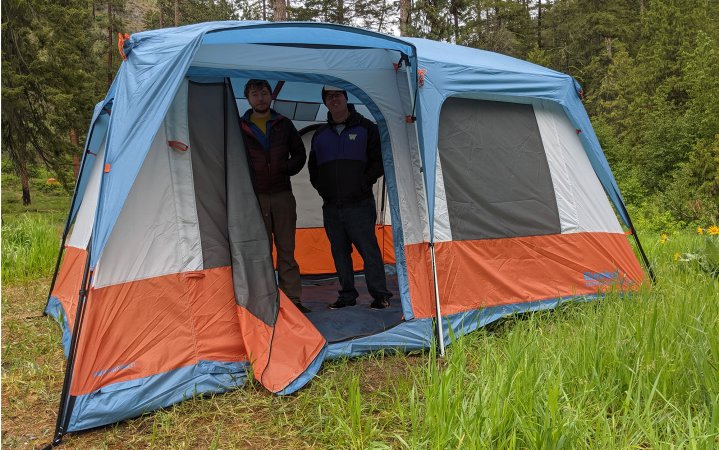
Buy the 4-Person, 6-Person, or 8-Person
Pros
- Spacious
- Great head height
- Very affordable
Cons
- Parent company discontinued the tent
- More complicated setup than most
Key Features
-
Price:
$130 to $300 -
Poles:
9 -
Doors:
1 -
Pockets:
2
Test Results
-
Ease of Setup:
Fair -
Interior Space:
Great -
Head Height:
Great -
Ventilation:
Great
We were beyond bummed to learn that Johnson Outdoors was discontinuing Eureka, makers of one of our favorite large tents. But the good news for you is that you can still find the Eureka Copper Canyon, at least until they run out of stock. Our testers have found that this one has excellent head height and is surprisingly resistant to rain, even when tents twice its price sprung a leak during testing. (We did find, however, that you need to strap the rainfly velcro around the poles if you anticipate moderate winds.) I had a family of three with a pup test this one during a long weekend and they reported that the eight-person version was very spacious for three cots and a dog crate. Multiple 6-foot-2-plus individuals were able to stand up inside this tent at the same time. Get this one now, as the steep discount it’s on will be gone forever once the stock runs out.
Best Blackout: Kelty Daydreamer
Photo by Laura Lancaster 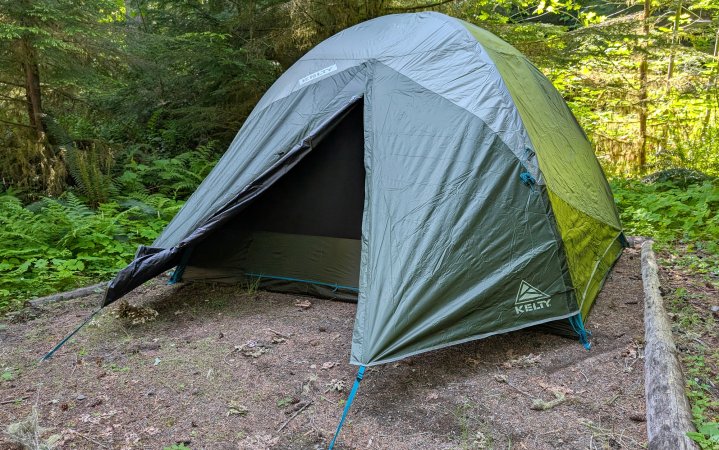
Buy the 4-Person
Buy the 6-Person
Pros
- Easy set up
- As dark as a moonless night
- Affordable
Cons
- Not the most durable materials
- Can’t close the back tent door from the inside
Key Features
-
Price:
$170 to $250 -
Poles:
4 -
Doors:
2 -
Pockets:
2
Test Results
-
Ease of Setup:
Great -
Interior Space:
Good -
Head Height:
Good -
Ventilation:
Great
If you like it to be dark when you sleep — I mean really dark — then the Kelty Daydreamer is a no-brainer. Fully enclosed, in the middle of the day, this thing is pitch black. I had a family with two very young children test this tent for me over a Memorial Day weekend. Their one year old in particular prefers to sleep in the dark, which can be a real problem for those summer nights when evening stretches out to eight, nine o’clock and beyond. The dad reported that the tot was a bit fussy when he first put him down to bed, so he headed out of the tent to close up the sunset zip in the back. By the time he got back inside, his son was already asleep. Of all the kids on my testing trip, the two in this tent woke up last.
Of course, it would have been nice if you could access the back door sunset feature without getting out of the tent, but that is a trade-off you make when a tent’s pricepoint is this low. Fortunately, the tent itself is easy enough to use. Two crisscrossing poles slot into tent sleeves and either side, with a rainfly thrown on top. This is marginally harder to set up and take down than one of the best instant tents, but not by much.
Best Forever Tent: Springbar Traveler
Photo by Ashley Thess 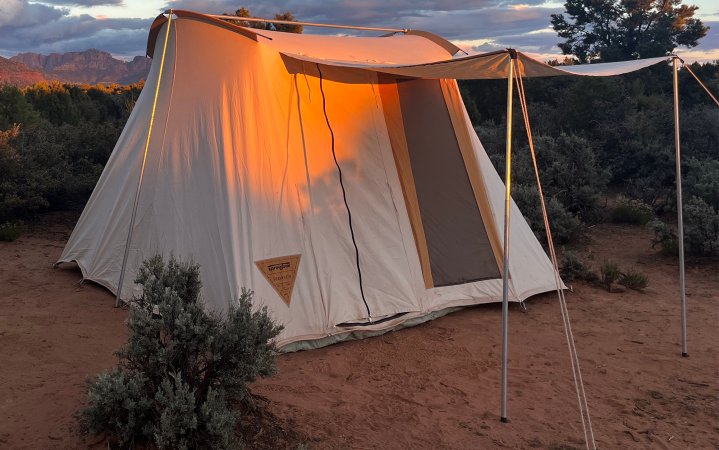
Buy from Springbar
Pros
- Reliable in all weather
- Durable enough to last a lifetime
- Made (and repaired) in the USA
- Comfortable and aesthetically pleasing
Cons
- Expensive
- Heavy
- Must hammer in 16 12-inch stakes
Key Features
-
Price:
$1,300 -
Poles:
10 -
Doors:
1 -
Pockets:
None
Test Results
-
Ease of Setup:
Poor -
Interior Space:
Great -
Head Height:
Great -
Ventilation:
Great
If your priorities when buying a tent are durability, reliability, and comfort then this is the best camping tent for your family. The Traveler is an all-canvas tent with aluminum and steel poles. I trust it with my life in the foulest weather: hail, wind, and rain. When I toured their factory in Salt Lake City, Utah, where they handmake their tents, a technician was repairing one from the 70s with just a bit of torn mesh. This is a tent that can last a lifetime, and possibly multiple generations, with the proper care.
The downside is that it isn’t freestanding, meaning you have to drive 16 galvanized steel stakes into the ground to keep it upright. But once it’s up, it isn’t going anywhere. Staking in the tent is far and away the hardest part; then it’s a breeze to erect and disassemble. And truth be told, I’ve gotten away with less stakes on hard desert earth.
The cotton canvas is warm in the cold and breathable in the heat thanks to the shrinking and contracting pores of natural fibers. The 100 square-foot living space is luxurious for two to four people, but you can fit up to six sleepers. The interior height is 6-feet, 5-inches anywhere you stand making it a great hang-out tent, too. If it’s too windy, rainy, or buggy outdoors, everyone can shelter inside instead of retreating to their individual tents, ending the night.
Read Next: The Best Canvas Tents
While a bit bulky and heavy, the packed size isn’t so different from other comparably sized tents, and you get a lot more peace of mind and comfort from the Springbar Traveler. It’s my go-to camping tent for groups, long trips, or impending weather. —Ashley Thess
Best Hot Tent: Nortent Gamme 6
Photo by Laura Lancaster 
Buy the Tent
Buy the Stove
Pros
- Be the hero for your friends and family
- Hang out late into the evening no matter the weather
- Uses less firewood than traditional campfires
Key Features
-
Price:
$1,550 (tent), $575 (stove) -
Poles:
5 -
Doors:
2 -
Pockets:
Test Results
-
Ease of Setup:
Fair -
Interior Space:
Good -
Head Height:
Good -
Ventilation:
Good
I first brought along the Nortent Gamme 6 — my pick for the best hot tent — for a Memorial Day weekend camping trip where the overnight lows were projected to be in the mid 30s, with a consistent on again, off again drizzle. Welcome to the start of summer in the Pacific Northwest.
A hot tent is a tent with a wood-burning stove inside. This one — from a Norwegian company that specializes in these designs — is floorless and made out of canvas. The stove is stainless steel and packs down separately from the rest of the tent. Once the tent is up (five crisscrossing poles) the stove itself is pretty straightforward. The stove pipe sections pack inside the body of the stove for easy travel; to use, you simply slot them together and insert through the dedicated hole in the top of the tent (there is a flap cover for when you want to use the Gamme as a regular tent).
Read Next: Best Hot Tents, Tested and Reviewed
On that first trip, the rain started up soon after we got the kids safely tucked under down blankets inside the tents. The adults retreated into the hot tent — plenty of space for camping chairs for more than six people, eight if you are using smaller chairs — and lit the stove. We stayed up til midnight and used about a tenth the amount of wood we would have to stay warm around a regular campfire. The hot tent has since become a regular addition to my kit for group outings, and has proven especially popular with women who run cold.
The Best Camping Tents: Also Great
NEMO Aurora Highrise
Photo by Laura Lancaster 
Buy the 4-Person
Buy the 6-Person
Pros
- Great warranty
- Plenty of ventilation
- Quality materials
- Good usable interior space
Cons
- Smaller vestibule
- Aggressive blue color
Key Features
-
Price:
$400 to $500 -
Poles:
4 -
Doors:
2 -
Pockets:
6
Test Results
-
Ease of Setup:
Good -
Interior Space:
Good -
Head Height:
Good -
Ventilation:
Great
The NEMO Aurora Highrise is a great camping tent. Its two crisscrossing poles are reinforced by two additional poles that run lengthwise across the tent, increasing both the usable floor space and head height significantly. It has two windows you can pop open for increased ventilation, and plenty of pockets. The materials are quality and it carries a lifetime warranty.
Read Next: The Best 6-Person Tents
But it’s only offered in blue, and this blue is very aggressive in the way it washes out colors on the inside of the tent. I didn’t dislike it exactly (and my kid kind of liked it) but it’s a very specific choice that there is no getting away from.
Wenzel Pinyon 10-Person Dome
Photo by Laura Lancaster 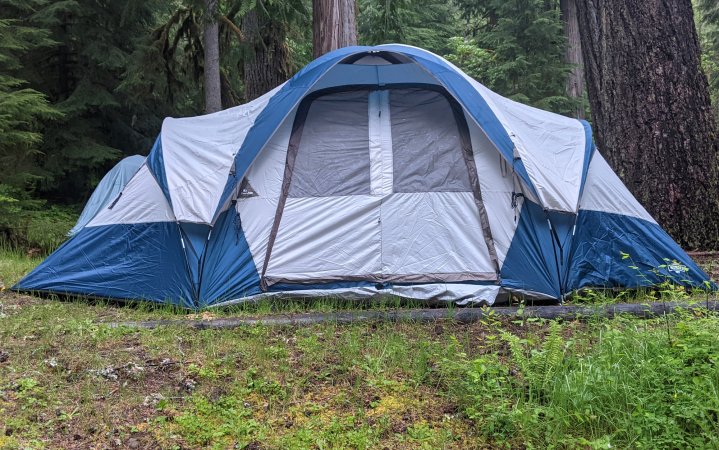
Buy the 10-Person
Pros
- Better than the alternatives
- Reasonably straight-forward setup
Cons
- Slightly smaller than you’d expect
- Reasonably affordable
Key Features
-
Price:
$250 -
Poles:
4 -
Doors:
1 -
Pockets:
4
Test Results
-
Ease of Setup:
Good -
Interior Space:
Good -
Head Height:
Good -
Ventilation:
Great
In my testing, I’ve found that there is basically an inverse relationship between tent size and quality. There are a ton of high-quality one and two person tents from dozens of brands using the latest and greatest materials. And there are still plenty of 4-person, 6-person, and even an 8-person tent or two that are still pretty good. But once you get to 10-person tents, the quality plummets. Poor design, bad waterproofing, flimsy fiberglass poles and tarp floors are the norm. If you can get by with a couple of six-person tents instead of a 10-person tent, I’d highly recommend going that route.
But if you do need a 10-person tent, the best of the lot that I’ve tested is the Wenzel Pinyon 10-Person Dome. It didn’t break on its first outing. It didn’t leak. And that was more than I could say for the other tents that I looked at for this story. The family that tested it asked if they could hold onto it, to replace a 14-person tent of lower quality.
Coleman Dark Room Skydome
Photo by Laura Lancaster 
Buy the 6-Person
Buy the 8-Person
Buy the 10-Person
Pros
- Quite dark
- Affordably priced
Cons
- Not quite as dark as the Daydreamer
- Slightly trickier setup than the Daydreamer
Key Features
-
Price:
$235 to $460 -
Poles:
3 -
Doors:
2 -
Pockets:
2
Test Results
-
Ease of Setup:
Fair -
Interior Space:
Good -
Head Height:
Great -
Ventilation:
Good
If you are looking for a blackout tent and the Kelty Daydreamer isn’t available, go with the Coleman Dark Room Skydome. It’s not quite as dark a tent, the setup is a little trickier (a third pole goes through a hidden sleeve along the top of the vestibule), and the materials aren’t quite at the same level, but it gets the job done just fine. The only other note here is that, in my testing, I’ve found that the Coleman tents run slightly smaller than other brands for the same claimed size.
The Best Camping Tents: The Rest of the Field
REI Campwell
Photo by Laura Lancaster 
Buy the 4-Person
Buy the 6-Person
Pros
- Affordable
- Easy to set up
Cons
- Low head height
- Only one door with no screen
- Uses fiberglass poles
Key Features
-
Price:
$230 to $300 -
Poles:
2 -
Doors:
1 -
Pockets:
6
Test Results
-
Ease of Setup:
Great -
Interior Space:
Fair -
Head Height:
Poor -
Ventilation:
Fair
If you aren’t familiar with REI’s house brand of gear, know that it is consistently one of the best values out there. It’s not the best of the best. And it’s not the lowest price. But if you rank the quality of any given product and compare it to its price, it’s usually one of the best deals around. So I was excited to check out their latest tent, the Campwell 4. Unfortunately, this one turned out to be a disappointment. While it is a low price, the quality of both the design and the materials felt lacking during setup, and to my testers who slept in it overnight.
The set up for this tent was fairly straightforward. Two crisscrossing poles go through sleeves at the top of the body of the tent and are secured at each corner via a pole sleeve. To get a tent pole into a tent sleeve it needs to have a lot of bend to it, so for this tent REI went for fiberglass poles instead of aluminum. I was a little disappointed to see this, as fiberglass poles are more prone to breaking than aluminum poles are. But they do have more bend, which is useful here. The rainfly then goes over the top, with some very obvious color coding at the corners (very helpful), helping to speed the process along. I was surprised to see the rainfly only cover the very top of the tent, and not the door. While there was no rain on my testing trip, that would be a major concern for the future.
Finally, this tent is very short for its size. Young children might be able to stand up inside of it, but my two testers, who are both on the taller side, definitely could not. They also noted that because the door doesn’t have a mesh option, the inside of the tent ended up getting a little stuffy overnight.
Bass Pro Shop 10-Person Cabin
Photo by Laura Lancaster 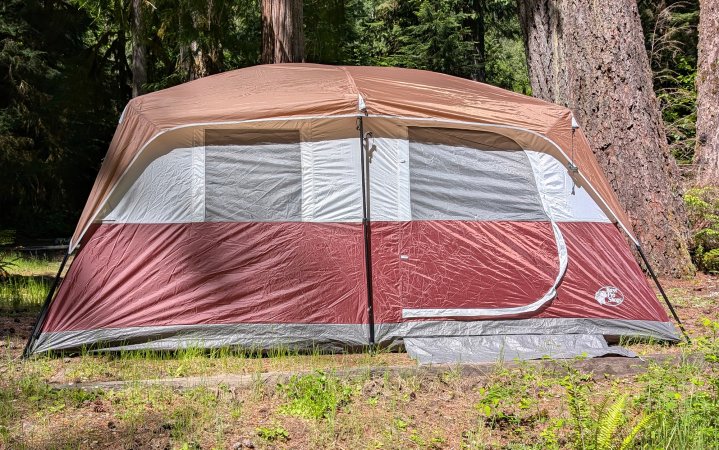
Buy the Bass Pro Shops version
Buy the Ozark Trails Version
Buy the Core Version
Pros
- Affordable
- Great interior space
Cons
- Carbon copy of others tents I’ve tested
- Only one door
- Very few pockets
- A pain to set up
Key Features
-
Price:
$220 -
Poles:
9 -
Doors:
1 -
Pockets:
2
Test Results
-
Ease of Setup:
Poor -
Interior Space:
Great -
Head Height:
Great -
Ventilation:
Good
I’ve now set up essentially three identical versions of this tent — the Bass Pro Shop 10-Person Cabin, the Ozark Trail Family Cabin Tent, and the Core 10-Person Family Camping Tent. If you decide to get this tent, go with whichever is least expensive. There is virtually no difference between them.
The main downside to choosing this particular tent is that it is a pain to set up. You start with three crisscrossing poles for the ceiling which you snap into place. You then need to take no fewer than six poles and attach them between the ceiling and the base of the tent to raise it up. Here is where there is one small difference that ever so slightly elevates the Bass Pro Shop 10-Person Cabin. They have two poles of different lengths for the center of the tent. That did make it easier to set this particular tent up compared to the others, but not enough to overcome any price differential.
Despite being a 10-person tent, there is only one door for this tent, and only two storage pockets. The family that shared this tent — three individuals and a dog — noted that this was a bit of a pain, especially if you have eyeglasses that you want to tuck somewhere safe when you get into bed.
How I Tested the Best Camping Tents
I have camped in hundreds of campgrounds across North America in conditions ranging from exposed desert to temperate rainforest to packed snow. In that time, I’ve camped solo, shared tents with a significant other, and a four-year-old kid that started camping when she was six months old. I drew on this wealth of experience to help determine which camping tents work best for different purposes.
For this story, I looked at a number of in-depth tests that Outdoor Life has done in the past, including the best 6-person tents, the best 8-person tents, the best instant tents, and the best canvas tents. I also tested a slew of other models from Mountain Hardwear, Decathlon, Heimplanet, Bass Pro Shops, REI, The North Face, and more.
How to Choose the Best Camping Tent
Size
If you are new to camping tents, know that a 4-person tent is not going to comfortably fit four people. Tents measure their size in sleeping pads, so a 4-person tent will just barely fit 4 sleeping pads with no room left over for gear or even getting out of the tent without stepping on other people. If you need space for four people, choose at least a 6-person if not an 8-person tent.
Ease of Setup
In recent years, so-called instant tents have become increasingly popular — in large part due to the notion that they are easier to set up than traditional tents. To an extent, this is true. Instant tents do set up pretty easy, especially if you have never set up a tent in your life. But traditional camping tents have also come a long way. Where once the trope of a jumbled mismash of poles and nylon was just a part of the hazing experience of learning to camp, today’s camping tents are color-coded with easy to use poles and rainflys.
Price
With camping tents, you get what you pay for. Budget tents might be a quarter of the price, but the lackluster materials they are using — fiberglass poles and thin sheets of nylon — basically guarantee that you can only expect a few seasons of use out of them. If you are looking for a camping tent to use for many years into the future, go with a higher priced pick as that will be a better value in the long run.
FAQs
The best tent brands are those that have decades of experience in the outdoors, be it camping or backpacking, and are attuned to how the engineering details of a tent make it more or less adaptable to different climates or weather conditions. Most, although not all, also use higher quality material that will typically last longer than lower grade nylon or polyester. Finally, a high-quality tent will have a long warranty period — if a manufacturer isn’t willing to guarantee their tent for more than a season, it probably isn’t any good.
The biggest factor in camping comfort is warmth. If you’re cold, you’re going to be uncomfortable. Purchasing a high quality sleeping pad will not only cushion you against the ground, but it will also insulate you from the cold of the ground. When choosing a sleeping bag, look for something rated at least twenty degrees lower than what you expect your coldest overnight temp to be. Bring blankets. Lots of blankets.
You cannot insulate a standard camping tent for winter. Consider purchasing a winter tent (which will provide additional insulation and structural support against snow loads) or looking into warmer layers and a sleeping bag.
Camping tents can cost anywhere from $100 to upwards of $1,000 or even more depending on their size and level of quality.
Final Thoughts on the Best Camping Tents
There is an impressive array of camping tents available, from massive 8-person palaces (with headroom for the whole family to two-person tents that are really only big enough for one. We’re confident that any of the picks on this list would serve you well on your next trip to the great outdoors.
Read the full article here







